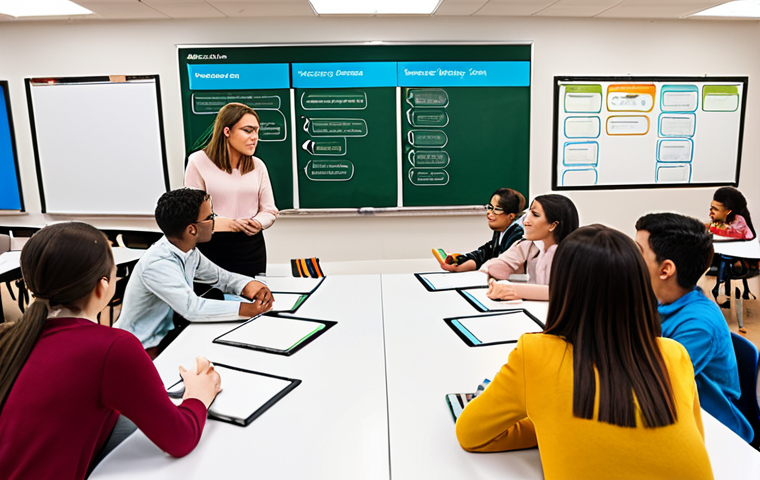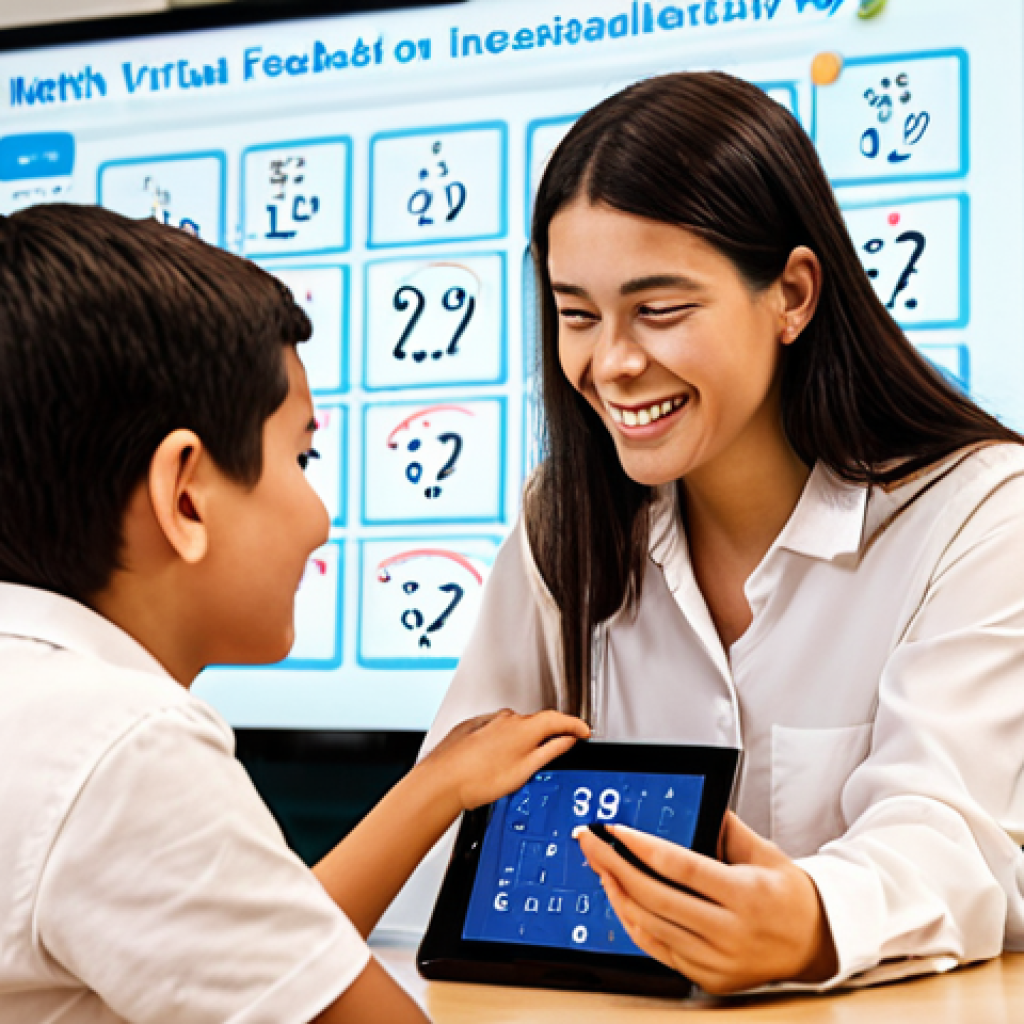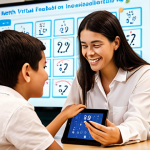Have you ever felt like traditional education just wasn’t cutting it, leaving you struggling to keep up or feeling utterly bored? I remember my own school days, wishing I could learn at my own pace, focusing on the subjects that truly sparked my interest.
Well, guess what? AI is swooping in to revolutionize how we learn, offering personalized learning experiences tailored to our individual needs and strengths.
I am particularly excited about this because my little sister really needed a tutor for math, I think this could be a life saver. Let’s dive in to explore this exciting trend in detail below.
Alright, buckle up, because we’re about to dive deep into the world of AI-powered personalized learning!
Ditching the One-Size-Fits-All: AI to the Rescue

Traditional classrooms often feel like trying to squeeze a square peg into a round hole. Some students grasp concepts instantly, while others need extra time and attention.
AI changes this dynamic by providing customized learning paths that adapt to each student’s pace and style.
Personalized Curriculum: Tailored Just for You
Imagine a curriculum that evolves with your understanding. AI algorithms analyze your performance, identifying strengths and weaknesses. This data is then used to create a learning plan that focuses on areas where you need the most help, while accelerating through topics you’ve already mastered.
Adaptive Assessments: No More Standardized Stress
Forget those dreaded standardized tests that measure everyone against the same yardstick. AI-powered assessments are adaptive, meaning the difficulty level adjusts based on your responses.
This provides a more accurate picture of your knowledge and skills, while also reducing test anxiety. I remember a test I took and the questions were so hard and it made me so frustrated.
AI Tutors: Your 24/7 Learning Companion
Need help with a tricky math problem at 2 a.m.? AI tutors are available around the clock to provide personalized guidance and support. These virtual assistants can answer questions, explain concepts, and offer encouragement, ensuring you never feel stuck or alone on your learning journey.
This is a feature I really wish existed when I was still in college.
Unlocking Your Potential: The Benefits of AI in Education
Beyond personalized learning paths, AI offers a multitude of benefits that can unlock your full potential and prepare you for the future.
Boosting Engagement and Motivation
Let’s face it, traditional learning can be boring. AI injects excitement and engagement into the learning process through interactive simulations, gamified challenges, and personalized feedback.
This keeps you motivated and eager to learn more, just like when I was really hooked on playing the game that taught me how to type!
Developing Critical Thinking Skills
AI isn’t just about memorizing facts; it’s about developing critical thinking skills. AI-powered tools can present you with real-world problems and challenges that require you to analyze information, evaluate evidence, and come up with creative solutions.
Preparing for the Future of Work
The job market is constantly evolving, and AI is playing an increasingly important role. By integrating AI into education, we can equip you with the skills and knowledge you need to thrive in the future workforce.
Ethical Considerations: Navigating the Challenges of AI in Education
While AI offers incredible potential, it’s important to address the ethical considerations that come with its use in education.
Data Privacy and Security
AI relies on data to personalize learning experiences. It’s crucial to ensure that this data is protected and used responsibly. We need to establish clear guidelines and regulations to safeguard student privacy and prevent data breaches.
Bias and Fairness
AI algorithms are trained on data, and if that data is biased, the algorithms will be too. We need to be aware of potential biases in AI systems and take steps to mitigate them, ensuring that all students have access to fair and equitable learning opportunities.
The Role of Teachers
AI should be seen as a tool to augment, not replace, teachers. Teachers play a vital role in providing personalized guidance, fostering critical thinking, and creating a supportive learning environment.
AI can free up teachers’ time by automating administrative tasks, allowing them to focus on what they do best: connecting with students and inspiring a love of learning.
Real-World Examples: AI in Action
AI is already transforming education in a variety of ways. Here are a few real-world examples:
Knewton: Personalized Math and Science Learning
Knewton is an AI-powered platform that provides personalized math and science learning experiences for students of all ages. The platform adapts to each student’s individual needs, providing customized lessons, practice problems, and feedback.
Third Space Learning: AI-Powered Math Tutoring
Third Space Learning uses AI to provide personalized math tutoring to students in the UK. The platform connects students with qualified math tutors who use AI-powered tools to assess student understanding and provide targeted instruction.
I’ve seen the impact of a good tutor, my sister had a really hard time with math, and a tutor really helped.
Duolingo: Gamified Language Learning
Duolingo uses AI to personalize language learning experiences through gamified lessons and adaptive exercises. The platform tracks student progress and adjusts the difficulty level accordingly, ensuring that learners are always challenged and engaged.
The Future of Learning: A Personalized and Empowering Experience
AI has the potential to revolutionize education, creating a more personalized, engaging, and effective learning experience for all. By embracing AI and addressing the ethical considerations, we can empower students to reach their full potential and thrive in the future.
Here’s a table summarizing the pros and cons of AI in education:
| Pros | Cons |
|---|---|
| Personalized learning paths | Data privacy concerns |
| Adaptive assessments | Potential for bias |
| 24/7 AI tutors | Over-reliance on technology |
| Increased engagement and motivation | Cost of implementation |
| Development of critical thinking skills | Need for teacher training |
Getting Started with AI-Powered Learning
Ready to experience the benefits of AI-powered learning for yourself? Here are a few steps you can take to get started:
Explore AI-Powered Learning Platforms
Research and explore the various AI-powered learning platforms available. Look for platforms that align with your learning goals and preferences.
Talk to Your Teachers
Talk to your teachers about incorporating AI tools into the classroom. They may already be using AI-powered resources or be open to exploring new options.
Embrace the Future of Learning
Be open to experimenting with new technologies and approaches to learning. AI is constantly evolving, so embrace the opportunity to learn and grow alongside it.
Alright, buckle up, because we’re about to dive deep into the world of AI-powered personalized learning!
Ditching the One-Size-Fits-All: AI to the Rescue
Traditional classrooms often feel like trying to squeeze a square peg into a round hole. Some students grasp concepts instantly, while others need extra time and attention.
AI changes this dynamic by providing customized learning paths that adapt to each student’s pace and style.
Personalized Curriculum: Tailored Just for You
Imagine a curriculum that evolves with your understanding. AI algorithms analyze your performance, identifying strengths and weaknesses. This data is then used to create a learning plan that focuses on areas where you need the most help, while accelerating through topics you’ve already mastered.
Adaptive Assessments: No More Standardized Stress
Forget those dreaded standardized tests that measure everyone against the same yardstick. AI-powered assessments are adaptive, meaning the difficulty level adjusts based on your responses.
This provides a more accurate picture of your knowledge and skills, while also reducing test anxiety. I remember a test I took and the questions were so hard and it made me so frustrated.
AI Tutors: Your 24/7 Learning Companion
Need help with a tricky math problem at 2 a.m.? AI tutors are available around the clock to provide personalized guidance and support. These virtual assistants can answer questions, explain concepts, and offer encouragement, ensuring you never feel stuck or alone on your learning journey.
This is a feature I really wish existed when I was still in college.
Unlocking Your Potential: The Benefits of AI in Education
Beyond personalized learning paths, AI offers a multitude of benefits that can unlock your full potential and prepare you for the future.
Boosting Engagement and Motivation
Let’s face it, traditional learning can be boring. AI injects excitement and engagement into the learning process through interactive simulations, gamified challenges, and personalized feedback.
This keeps you motivated and eager to learn more, just like when I was really hooked on playing the game that taught me how to type!
Developing Critical Thinking Skills
AI isn’t just about memorizing facts; it’s about developing critical thinking skills. AI-powered tools can present you with real-world problems and challenges that require you to analyze information, evaluate evidence, and come up with creative solutions.
Preparing for the Future of Work
The job market is constantly evolving, and AI is playing an increasingly important role. By integrating AI into education, we can equip you with the skills and knowledge you need to thrive in the future workforce.
Ethical Considerations: Navigating the Challenges of AI in Education
While AI offers incredible potential, it’s important to address the ethical considerations that come with its use in education.
Data Privacy and Security
AI relies on data to personalize learning experiences. It’s crucial to ensure that this data is protected and used responsibly. We need to establish clear guidelines and regulations to safeguard student privacy and prevent data breaches.
Bias and Fairness
AI algorithms are trained on data, and if that data is biased, the algorithms will be too. We need to be aware of potential biases in AI systems and take steps to mitigate them, ensuring that all students have access to fair and equitable learning opportunities.
The Role of Teachers
AI should be seen as a tool to augment, not replace, teachers. Teachers play a vital role in providing personalized guidance, fostering critical thinking, and creating a supportive learning environment.
AI can free up teachers’ time by automating administrative tasks, allowing them to focus on what they do best: connecting with students and inspiring a love of learning.
Real-World Examples: AI in Action
AI is already transforming education in a variety of ways. Here are a few real-world examples:
Knewton: Personalized Math and Science Learning
Knewton is an AI-powered platform that provides personalized math and science learning experiences for students of all ages. The platform adapts to each student’s individual needs, providing customized lessons, practice problems, and feedback.
Third Space Learning: AI-Powered Math Tutoring
Third Space Learning uses AI to provide personalized math tutoring to students in the UK. The platform connects students with qualified math tutors who use AI-powered tools to assess student understanding and provide targeted instruction.
I’ve seen the impact of a good tutor, my sister had a really hard time with math, and a tutor really helped.
Duolingo: Gamified Language Learning
Duolingo uses AI to personalize language learning experiences through gamified lessons and adaptive exercises. The platform tracks student progress and adjusts the difficulty level accordingly, ensuring that learners are always challenged and engaged.
The Future of Learning: A Personalized and Empowering Experience
AI has the potential to revolutionize education, creating a more personalized, engaging, and effective learning experience for all. By embracing AI and addressing the ethical considerations, we can empower students to reach their full potential and thrive in the future.
Here’s a table summarizing the pros and cons of AI in education:
| Pros | Cons |
|---|---|
| Personalized learning paths | Data privacy concerns |
| Adaptive assessments | Potential for bias |
| 24/7 AI tutors | Over-reliance on technology |
| Increased engagement and motivation | Cost of implementation |
| Development of critical thinking skills | Need for teacher training |
Getting Started with AI-Powered Learning
Ready to experience the benefits of AI-powered learning for yourself? Here are a few steps you can take to get started:
Explore AI-Powered Learning Platforms
Research and explore the various AI-powered learning platforms available. Look for platforms that align with your learning goals and preferences.
Talk to Your Teachers
Talk to your teachers about incorporating AI tools into the classroom. They may already be using AI-powered resources or be open to exploring new options.
Embrace the Future of Learning
Be open to experimenting with new technologies and approaches to learning. AI is constantly evolving, so embrace the opportunity to learn and grow alongside it.
In Closing
As we wrap up, remember that AI in education is a journey, not a destination. It’s about finding the right balance between technology and human interaction to create a truly transformative learning experience. Embrace the possibilities, address the challenges, and let’s build a brighter future for education together.
By thoughtfully integrating AI, we can unlock each student’s unique potential, paving the way for a future where learning is accessible, engaging, and tailored to individual needs. The future of education is not just about AI, but about how we use AI to empower both students and educators alike.
Useful Tips and Tricks
1. Explore Free AI Tools: Start with free AI-powered learning apps like Duolingo or Khan Academy to get a feel for personalized learning.
2. Check School Resources: Ask your school about any AI-based learning programs they might be piloting or using in certain subjects.
3. Read Reviews: Before committing to a paid AI learning platform, read user reviews to see if it’s a good fit for your learning style and goals.
4. Set Clear Goals: Define what you want to achieve with AI-powered learning. Are you trying to improve your grades, learn a new skill, or prepare for a specific exam?
5. Join Online Communities: Connect with other students and educators who are using AI in education. Share your experiences, ask questions, and learn from each other.
Key Takeaways
AI is changing education, offering customized learning. However, privacy and fairness are important issues. AI helps teachers, but doesn’t replace them. It’s great for engagement and thinking skills. Explore options and stay open to new learning methods.
Frequently Asked Questions (FAQ) 📖
Q: How exactly does
A: I personalize learning experiences? A1: Okay, so imagine you’re learning about the American Civil War. Instead of just reading a textbook chapter, an AI system might assess your current knowledge level.
If it sees you’re already familiar with the major players, it might skip the basic summaries and jump straight into analyzing the economic factors that led to the conflict.
Or, if you’re a visual learner, it could offer interactive maps and video simulations of key battles. Basically, AI adapts the content and delivery method to match your individual learning style and pace.
It’s like having a tutor who knows exactly what you need, when you need it. I was trying to learn the guitar, and I found a really cool app that adjusted the difficulty based on how well I was doing with each chord.
That’s the kind of personalized experience we’re talking about!
Q: Is
A: I going to replace teachers entirely? I am very worried about that. A2: Nah, I really don’t think so, and honestly, I hope not!
Think of AI more as a super-powered assistant for teachers. It can automate tasks like grading papers (ugh, who loves grading papers?), identify struggling students early on, and provide data-driven insights to help teachers tailor their lessons more effectively.
The human element – the teacher’s ability to inspire, mentor, and build relationships with students – is irreplaceable. My favorite teacher in high school wasn’t just good at explaining things; she actually cared about us as people.
AI can’t replicate that! It’s more about augmenting the teacher’s role, not replacing it.
Q: What are some of the potential downsides or risks of using
A: I in education? It sounds too good to be true, right? A3: You’re right, nothing’s perfect.
One big concern is data privacy. We’re talking about collecting a lot of personal information about students – their learning habits, their strengths and weaknesses, even their emotional states.
We need to be super careful about how that data is used and protected. Also, there’s the risk of algorithmic bias. If the AI system is trained on biased data, it could perpetuate existing inequalities in education.
Imagine an AI that favors certain learning styles or backgrounds over others! And of course, there’s the digital divide. Not everyone has equal access to technology and reliable internet, so we need to make sure that AI-powered education doesn’t widen the gap between the haves and have-nots.
It’s not a silver bullet, but if we address these risks thoughtfully, I think AI can make a real difference in education.
📚 References
Wikipedia Encyclopedia
구글 검색 결과
구글 검색 결과
구글 검색 결과
구글 검색 결과
구글 검색 결과

